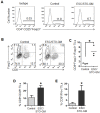Vaccination with embryonic stem cells protects against lung cancer: is a broad-spectrum prophylactic vaccine against cancer possible?
- PMID: 22860107
- PMCID: PMC3409174
- DOI: 10.1371/journal.pone.0042289
Vaccination with embryonic stem cells protects against lung cancer: is a broad-spectrum prophylactic vaccine against cancer possible?
Abstract
The antigenic similarity between tumors and embryos has been appreciated for many years and reflects the expression of embryonic gene products by cancer cells and/or cancer-initiating stem cells. Taking advantage of this similarity, we have tested a prophylactic lung cancer vaccine composed of allogeneic murine embryonic stem cells (ESC). Naïve C57BL/6 mice were vaccinated with ESC along with a source of granulocyte macrophage-colony stimulating factor (GM-CSF) in order to provide immunostimulatory adjuvant activity. Vaccinated mice were protected against subsequent challenge with implantable Lewis lung carcinoma (LLC). ESC-induced anti-tumor immunity was not due to a non-specific "allo-response" as vaccination with allogeneic murine embryonic fibroblasts did not protect against tumor outgrowth. Vaccine efficacy was associated with robust tumor-reactive primary and memory CD8(+) T effector responses, Th1 cytokine response, higher intratumoral CD8(+) T effector/CD4(+)CD25(+)Foxp3(+) T regulatory cell ratio, and reduced myeloid derived suppressor cells in the spleen. Prevention of tumorigenesis was found to require a CD8-mediated cytotoxic T lymphocyte (CTL) response because in vivo depletion of CD8(+) T lymphocytes completely abrogated the protective effect of vaccination. Importantly, this vaccination strategy also suppressed the development of lung cancer induced by the combination of carcinogen administration and chronic pulmonary inflammation. Further refinement of this novel vaccine strategy and identification of shared ESC/tumor antigens may lead to immunotherapeutic options for lung cancer patients and, perhaps more importantly, could represent a first step toward the development of prophylactic cancer vaccines.
Conflict of interest statement
Figures







Similar articles
-
Vaccination with allogeneic GM-CSF gene-modified lung cancer cells: antitumor activity comparing with that induced by autologous vaccine.Cancer Biother Radiopharm. 2007 Dec;22(6):790-8. doi: 10.1089/cbr.2007.360. Cancer Biother Radiopharm. 2007. PMID: 18158770
-
Exosomes from GM-CSF expressing embryonic stem cells are an effective prophylactic vaccine for cancer prevention.Oncoimmunology. 2019 Jan 9;8(3):1561119. doi: 10.1080/2162402X.2018.1561119. eCollection 2019. Oncoimmunology. 2019. PMID: 30723593 Free PMC article.
-
Efficacy of GM-CSF-producing tumor vaccine after docetaxel chemotherapy in mice bearing established Lewis lung carcinoma.J Immunother. 2006 Jul-Aug;29(4):367-80. doi: 10.1097/01.cji.0000199198.43587.ba. J Immunother. 2006. PMID: 16799332
-
Exosome-based cancer vaccine for prevention of lung cancer.Stem Cell Investig. 2023 Jan 9;10:2. doi: 10.21037/sci-2022-030. eCollection 2023. Stem Cell Investig. 2023. PMID: 36742283 Free PMC article.
-
[Novel vaccines against M. tuberculosis].Kekkaku. 2006 Dec;81(12):745-51. Kekkaku. 2006. PMID: 17240920 Review. Japanese.
Cited by
-
Induced Pluripotent Stem Cell-Based Cancer Vaccines.Front Immunol. 2019 Jul 8;10:1510. doi: 10.3389/fimmu.2019.01510. eCollection 2019. Front Immunol. 2019. PMID: 31338094 Free PMC article. Review.
-
Development of the T-ALLiPSC-based therapeutic cancer vaccines for T-cell acute lymphoblastic leukemia.Med Oncol. 2022 Sep 29;39(12):200. doi: 10.1007/s12032-022-01809-6. Med Oncol. 2022. PMID: 36173527
-
Immunobiology and signaling pathways of cancer stem cells: implication for cancer therapy.Cytotechnology. 2015 Oct;67(5):749-59. doi: 10.1007/s10616-014-9830-0. Epub 2014 Dec 17. Cytotechnology. 2015. PMID: 25516358 Free PMC article.
-
Pluripotent Stem Cells: Cancer Study, Therapy, and Vaccination.Stem Cell Rev Rep. 2021 Dec;17(6):1975-1992. doi: 10.1007/s12015-021-10199-7. Epub 2021 Jun 11. Stem Cell Rev Rep. 2021. PMID: 34115316 Free PMC article. Review.
-
Mechanism of inhibiting proliferation of hepatocellular carcinoma Hepa1-6 cells by embryonic stem cell-conditioned medium.Exp Ther Med. 2020 Apr;19(4):2406-2414. doi: 10.3892/etm.2020.8527. Epub 2020 Feb 12. Exp Ther Med. 2020. PMID: 32226485 Free PMC article.
References
-
- Triolo VA (1965) Nineteenth Century Foundations of Cancer Research Advances in Tumor Pathology, Nomenclature, and Theories of Oncogenesis. Cancer Res 25: 75–106. - PubMed
-
- Al-Hajj M, Clarke MF (2004) Self-renewal and solid tumor stem cells. Oncogene 23: 7274–7282. - PubMed
-
- Stonehill EH, Bendich A (1970) Retrogenetic expression: the reappearance of embryonal antigens in cancer cells. Nature 228: 370–372. - PubMed
-
- Baldwin RW, Glaves D, Vose BM (1972) Embryonic antigen expression in chemically induced rat hepatomas and sarcomas. Int J Cancer 10: 233–243. - PubMed
-
- Baldwin RW, Glaves D, Pimm MV, Vose BM (1972) Tumour specific and embryonic antigen expression of chemically induced rat tumours. Ann Inst Pasteur (Paris) 122: 715–728. - PubMed
Publication types
MeSH terms
Substances
Grants and funding
LinkOut - more resources
Full Text Sources
Other Literature Sources
Molecular Biology Databases
Research Materials

